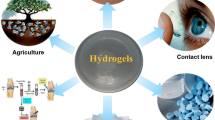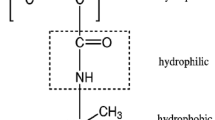Abstract
New dual stimuli-responsive (thermo- & pH-) polymers were successfully synthesized through an atom transfer radical mechanism in aqueous media. N-Isopropylacrylamide (NiPAM) ([N]) as a precursor of temperatureresponsive moiety and sulfonamide-modified styrenic monomer and methacrylamide ([S]) were employed for the synthesis of the smart copolymers. The molar ratio of NiPAM to sulfonamide composed of the polymer backbone played an important role in the control of the phase transitional behavior of the formed block polymers. When the composition ratio of [S]/[N] decreases from 1/1 to 1/2, the dual stimuli-responsive phase behavior was clearly observed. Another important factor for the control of the phase morphology was to obtain the reactivity ratios, r 1 and r 2, of the two monomers. In this study, Cu(I)-catalyzed copolymerization of sulfadimethoxinyl methacrylamide (MASX; M1) and NiPAM (M2) as the precursors of smart materials yielded r 1 = 8.046 and r 2=1.572, leading to the production of a gradient type of copolymer in aqueous media.

Similar content being viewed by others
References
I. C. Kwon, Y. H. Bae, and S. W. Kim, Nature, 354, 291 (1991).
A. Prokop, E. Kozlov, G. Carlesso, and J. M. Davidson, Adv. Polym. Sci., 160, 119 (2002).
A. S. Hoffmann, in Controlled Drug Delivery: Challenges and Strategies, K. N. Park, Ed., Am. Chem. Soc., Washington, D. C., 1997, Chap. 24, pp 485–498.
G. Chen and A. S. Hoffmann, Nature, 373, 49 (1995).
D. J. Beebe, J. S. Moore, J. M. Bauer, Q. Yu, R. H. Liu, C. Devadoss, and B.-H. Jo, Nature, 404, 588 (2000).
Y. Hirokawa and T. Tanaka, J. Chem. Phys., 81, 6379 (1984).
S. Hirotsu, Y. Hirokawa, and T. Tanaka, J. Chem. Phys., 87, 1392 (1987).
H. Feil, Y. H. Bae, J. Feijen, and S. W. Kim, Macromolecules, 26, 2496 (1993).
G. Wang and P. Wu, Langmuir, 32, 3728 (2016).
G. Abel, T. A. Connors, W. C. J. Ross, N.-H. Nam, H. Hoellinger, and L. Pichat, Eur. J. Cancer, 9, 49 (1973).
C. T. Supuran, A. Casini, and A. Scozzafava, Med. Res. Rev., 23, 535 (2003).
C. A. Spinks, G. M. Wyatt, H. A. Lee, and M. R. A. Morgan, Bioconjug. Chem., 10, 583 (1999).
S. Y. Park and Y. H. Bae, Macromol. Rapid Commun., 20, 269 (1999).
K. M. Kim, S. Choi, H. J. Jeon, J. Y. Lee, D. Choo, J. Kim, Y. S. Kang, and H.-O. Yoo, Macromol. Res., 16, 169 (2008).
K. Matyjaszewski and J. Xia, Chem. Rev., 101, 2921 (2001).
M. Kamigaito, T. Ando, and M. Sawamoto, Chem. Rev., 101, 3689 (2001).
H. Cheng, S. Xie, Y. Zhou, W. Huang, D. Yan, J. Yang, and B. Ji, J. Phys. Chem. B, 114, 6291 (2010).
F. A. Plamper, M. Ruppel, A. Schmalz, O. Borisov, M. Ballauff, and A. H. E. Muller, Macromolecules, 40, 8361 (2007).
M. Nakayama, Y. Kawahara, J. Akimoto, H. Kanazawa, and T. Okano, Colloids Surf. B: Biointerf., 99, 12 (2012).
H. Ringsdorf, J. Polym. Sci., Symp., 51, 135 (1975).
M. Finemann and S. D. Ross, J. Polym. Sci., 5, 259 (1950).
H. J. Harwood, Macromol. Symp., 10/11, 331 (1987).
J. M. G. Cowie, in Comprehensive Polymer Science, E. S. Eastman, A. Ledwith, S. Russo, and P. Sigwalt, Eds., Pergamon, New York, 1989, Vol. 4, pp 331–354.
K. Matyjaszewski, M. Ziegler, S. V. Arehart, D. Greszta, and T. Pakula, J. Phys. Org. Chem., 13, 775 (2000).
S. Qin, J. Saget, J. Pyun, S. Jia, T. Kowalewski, and K. Matyjaszewski, Macromolecules, 36, 8969 (2003).
U. Beginn, Colloid Polym. Sci., 286, 1465 (2008).
S. Liu and S. P. Armes, Angew. Chem. Int. Ed., 41, 1413 (2002).
V. Butun, N. C. Billingham, and S. P. Armes, J. Am. Chem. Soc., 120, 11818 (1998).
R. Savic, L. Luo, A. Eisenberg, and D. Maysinger, Science, 300, 615 (2003).
G. Zhang, A. Niu, S. Peng, M. Jiang, Y. Tu, M. Li, and C. Wu, Acc. Chem. Res., 34, 249 (2001).
Author information
Authors and Affiliations
Corresponding author
Electronic supplementary material
Rights and permissions
About this article
Cite this article
Siddique, A.B., An, J.W., Kim, H.J. et al. Synthesis of dual stimuli-responsive polymers through atom transfer radical mechanism in aqueous media. Macromol. Res. 25, 70–78 (2017). https://doi.org/10.1007/s13233-017-5004-1
Received:
Revised:
Accepted:
Published:
Issue Date:
DOI: https://doi.org/10.1007/s13233-017-5004-1




